Garden Design Study Group: Kennedy Garden
Wheeler’s Hill, Victoria
Background Data
Sources |
Garden Visit and interview with owners, June 10, 2015. Written article in Growing Australian. |
Area |
2/3 acre, north facing. |
Overlays |
Vegetation Protection Overlay. |
Climate |
Cool temperate. |
Soil |
Clay. |
Mulch |
Wood chips, garden-generated mulch, some sand. |
Photographs |
Helen and Max Kennedy. |
Click on the smaller images to view larger images.
 |
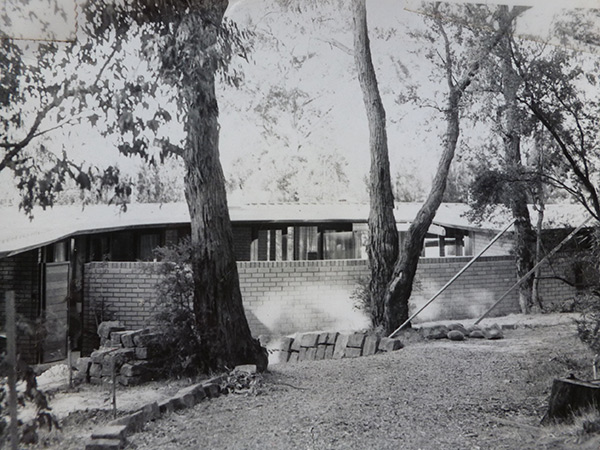 |
| Top: Article in The Age with house design Bottom: Looking down the drive to courtyard wall – 1960s |
Helen and Max Kennedy’s large Australian plant garden in Wheelers Hill is surely one of the most beautiful, natural-style gardens in the Melbourne region. Wheelers Hill/Glen Waverley today is an established south-eastern suburb 19 km from the CBD, but when Max and Helen purchased their 2/3 acre in 1963 on what was a small enclave where all blocks were a minimum ½ acre, it was a true ‘bush block’: a grassy, wooded slope with a view across open country to the distant Dandenong Ranges. There were no made roads or fences and the indigenous vegetation on the site was dominated by allocasuarinas, bursarias and tall stringy-bark eucalypts – some of which still remain as venerable specimens in the garden. While much of Melbourne is on the sand-belt that is not the case in this part of Waverley: the Kennedys’ block was heavy yellow clay, and although over the years it has been ameliorated it still does not make for easy gardening.
To design their house, Helen and Max chose David Godsell, a rising young architect with a reputation for innovative ideas. He gave them a north-facing, curved house with extensive glass doors and walls to take full advantage of the views. They chose well, as the house is now listed on the National Trust Register of Buildings of Architectural Significance.
The Early Days
Along with many other people at that time, the Kennedys were keen to create an Australian plant garden and as few were then commercially available they mostly bought tiny, inexpensive Forestry Commission tubes of largely unfamiliar eucalypts – some of which are now the giants of the garden. According to Helen, it was a case of ‘plant and forget’, with little consideration given to care and maintenance, as “full-time work in a demanding job and a growing family meant that there was little left-over time or energy to do much more.”
Although the development of the garden was necessarily piecemeal, from the beginning Helen and Max decided that garden beds, paved areas and paths should be curved, to complement the shape of the house. They also wanted to enjoy the house and garden as a single entity: “… to make the most of the indoor/outdoor feel afforded by walls of glass”.
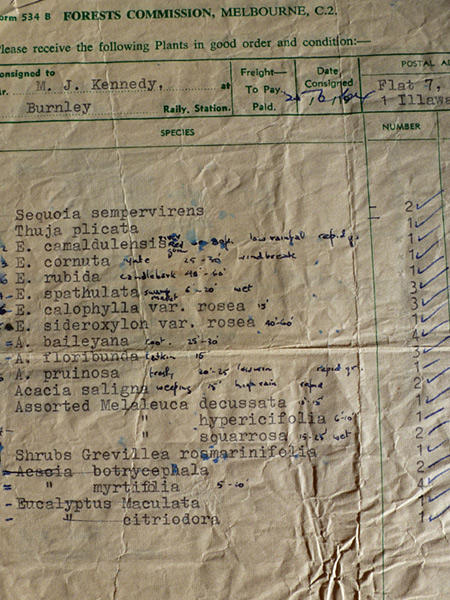 |
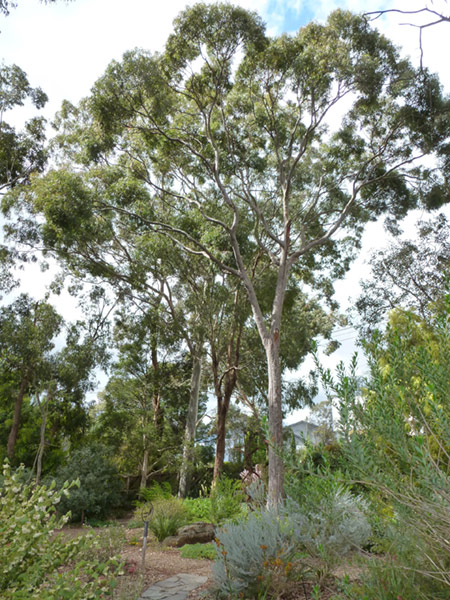 |
|
| Left: Plants for 2/6d each! Right: Angophera costata and tall eucalypts |
||
Helen describes the evolution of the garden and its design as ‘retrospective gardening’ as in the beginning they had little knowledge of Australian plants or how to create the best growing environments for particular plants. “We made lots of errors in those early days, and have long since removed many original plantings that grew too big or unsightly, often through inappropriate location or lack of pruning.” (Her words are likely to resonate with many Australian plant enthusiasts!).
Retirement from work provided the impetus for a greater focus on the garden. An increasing connection to APS (Australian Plants Society) and visits to other people’s gardens expanded Helen’s knowledge and “… fuelled the desire to experiment with what we could grow and to have one of each wonderful Australian plant to hit the market. It was such a thrill if something that grew naturally in laterite or sand thrived in our Glen Waverley clay”. Over time, however, the garden began to seem more “a motley collection of impulse buys” than a cohesive structure, and eventually Helen found the lack of design deeply unsatisfying. “The need to create a more unified space where the planting complemented a more aesthetic base structure grew stronger. Over the years, with the help of professionals who have added greatly to our knowledge of garden design, there has been a gradual transformation, so that now the garden is finally close to meeting my aspirations.”
The Garden Today
Structure and Design
 |
 |
|
| Left: Tuscan topping path leading into front garden Right: Slate path leading to a bird bath, front garden |
||
Like all good gardens, the Kennedy garden has evolved over time, but the basic concept of informal, curved garden-beds and winding gravel paths to give access to all areas of the garden has remained a guiding principle. The gravel used for most of the paths is Tuscan topping, a creamy, orange-brown stone that perfectly complements the informal feel of the garden. As this is a corner block, entry is from the side street with a driveway leading to the house entry and rear garden; the low fence means that passers-by can enjoy this large garden area too.
The front garden is the most extensive area and contains a huge variety of plants, several of them rare or unusual. Screening trees and shrubs line the high fences here and although initially a large exotic lawn was planted to meet the needs of two young boys, this has now been replaced by garden beds and a swathe of mown Australian grasses. Directly in front of the house are garden beds and a slate- paved patio area leading to the spa and natural-style swimming pool – an integral part of the garden, giving pleasure all year round from the reflections of eucalypts in the black water.
Its construction in 1984 was the impetus for extensive new paving and planting and the resultant large patio is a favourite place for Max and Helen to enjoy the garden during the summer months. Garden sculptures and container plants, including a collection of mature cycads, add beauty and interest to the patio, while in front of it colourful plants trail over a low bluestone wall, with larger plants forming the background.
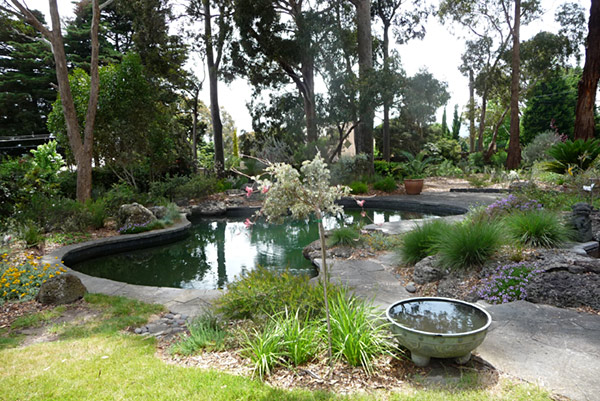
The swimming pool – looking from the front of the house
Because of the slope across the block, drainage and water control were problems for many years. Eventually the Kennedys asked landscape designer and friend, Bev Hanson, for advice on how to deal with the problem of rain scouring the front garden after heavy rain. The result was the creation of swales in the gravel pathways and grassy area to slow the water and direct it into the garden beds; this has proved highly effective.
A more difficult problem, however, was how to stop water from heavy rainfalls racing across the back garden and washing away much of the loose gravel driveway. Two solutions were finally found. First, drainage was built into the driveway and the gravel replaced with aggregate paving using pebbles that matched the colours of the Tuscan topping. Second, after a particularly heavy downpour caused flooding in the house, the Kennedys called on the services of Philip Johnson, a garden designer renowned for his creative and beautiful water-features, to solve the problem and give Helen a much longed-for frog pond.
 |
 |
|
| Left: Japanese bell at courtyard – and house – entry Right: The Japanese courtyard |
||
The result is a magnificent water-course and ephemeral pool; after rain, water flows through a channel lined with boulders, down rocky outcrops and into the pond below. This provides a home not only for frogs, visiting wildlife and lush aquatic plants but also for attractive garden ornaments such as the quirky antique Chinese frog and three elegant rusted-steel brolgas. (However, Max – who has the responsibility of keeping the pond clear – sometimes wishes the plant-growth were somewhat less prolific!).
Not all of Helen and Max’s garden is Australian. They have long had a love affair with Japanese culture, and the main entry to the house is through a curved brick wall which reveals a very private, small Japanese-style courtyard. From the gallery windows Helen and Max look out upon a secluded garden of azaleas, maples and mondo grass surrounding two reflective pools, and an antique stone water bowl. They felt that a separate, enclosed area would be a permanent reminder of gardens they had loved in that country and would provide an attractive foil for the rest of the garden.
Helen likes a soft, rather than showy garden, and preferred flower colours are blue, mauve, yellow, pink and white. Silver-grey foliage is a great love, while dampieras, thomasias, dwarf banksias and grevilleas are special favourites. Grasses and strappy plants like lomandra, orthrosanthus and dianellas provide sculptural contrast, while the many sitting-places and wide pathways fulfil the necessary requirement in good garden design of balancing ‘mass and void’. Plants having the same water requirements are generally grouped together and Helen likes to have different species of a genus growing beside each other – an interesting form of ‘repeat planting’.
An outstanding feature of the garden is the placement throughout of large and small container plants along with sculptures and garden ornaments, which lend a touch of formality to an otherwise informal, naturalistic setting. Water-bowls abound, not only providing pleasure for the birds but also enhancing the tranquil feel of the garden. Visiting birds include New Holland Honeyeaters, Gang-gangs and King parrots, while the occasional presence of Tawny Frogmouths roosting almost invisibly in eucalypts close to the house is a particular delight.
 |
 |
|
 |
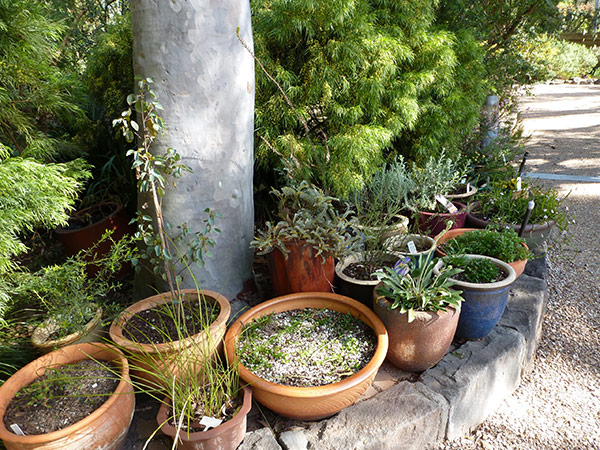 |
|
| Top Row Left: King parrots in the courtyard Top Row Right: Sculpture Bottom Row: Colourful container plants |
||
A Walk Through the Garden
Entry to the house is from a gateway in the side fence and immediately in this densely-planted, spacious ‘back yard’ one is surrounded by mature and beautiful trees and shrubs. Alongside the driveway, close to the house, is a collection of colourful container plants including orchids, dampieras and scaevolas – some of Helen’s favourites – while a little way down the drive and off to the right the ‘bursaria area’ opens up: a peaceful gravelled sitting-place underneath the gnarled old trees which together with tall eucalypts also growing there, are remnants of the indigenous vegetation. The understorey contains plants chosen for their ability to grow happily in this dry shade – mainly thomasias, cordylines, several dwarf Acacia cognata, Plectranthus argentatus (Silver Plectranthus), and a large and spectacular Doryanthus palmeri, (Spear Lily).
Entry to the front garden is through a gated fernery, built by Max who still does most of the heavy construction work, and growing well in this shady spot are several species of ferns, clumps of Crinum pedunculata (Swamp Lily) and many orchids: some in hollow tree-trunks, some in hanging baskets and some in bowls on the stone table. They include the small pink or white flowered Thelichiton kingiatum (King Orchid), the spectacular creamy-yellow flowered Thelichiton speciosa (Rock Lily) and delicate, green-flowered Pterostylis (Greenhoods).
Along the pathway on the eastern side of the front garden is an open section where sun-loving plants with low-water requirements such as eremophilas and dwarf banksias grow in company with an assortment of Isopogon species. Dominating the area is the grafted Grevillea petrophiloides ‘Pink Poker’, with its spectacular pink, arching flower-spikes. Tall screening plants such as Leptospermum species, Acacia cognata ‘Lime Magic’, A. ‘Buchan Blue’ and a variety of eucalypts line the side fence, while smaller plants, including eremophilas, halganias, dampieras, prostrate acacias, melaleucas and petrophiles extend the bed towards the centre of the garden.
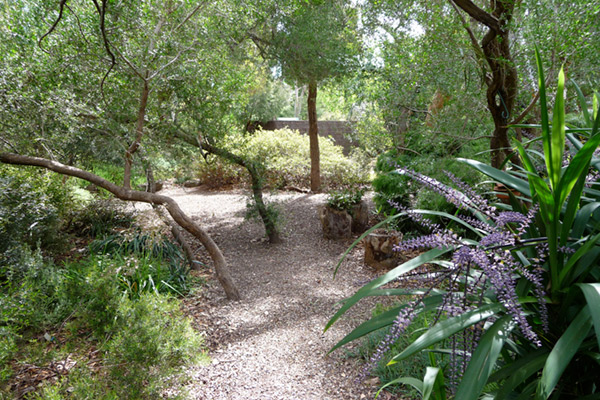
The ‘bursaria area’
The two island beds in front of the house are both dominated by tall trees. A beautiful Angophora costata is in the long bed, while several ancient eucalypts shade the bed in the far front corner of the garden. Because the angophora bed is sunny a variety of plants thrive there, including dampiera, spyridium and micromyrtus. In the drier, shadier areas, Persoonia chamaepitys and phebaliums are among the plants that are doing well, while in the bottom corner of the garden and obviously very happy in the clay-based soil is a spreading Acacia glaucoptera (Clay Wattle), with its striking red new growth.
 |
 |
| Top: Path and long garden bed with angophera Bottom: Looking into the fernery from the front garden |
The pathway on the northern side of the front garden skirts the swimming-pool and beside it the dividing fence is screened by large trees, shrubs and a variety of creepers – billardiera, kennedia and hardenbergia among them. Curving around the pool is a mounded bed constucted from the excavation, and although barrow-loads of gypsum and compost were dug into the clay it has been the slowest bed for growth. Nevertheless, it is a sunny spot where grevilleas, eremophilas and grasses gradually do well, while the tallest xanthorrhea in the garden is a feature plant.
Return to the back garden is through a gate and in an open, sunny spot beside the house Helen has a small vegetable and herb patch that includes several species of native-citrus – all growing happily in containers or circular galvanised-iron raised beds. The path which finally leads uphill to the driveway, continues alongside the frog-pond, where among the rocks and grasses a Myoporum floribunda leans its delicate branches over the water. Other noteworthy plants in this area are Grevillea ‘Ivory Whip’ with its creamy-pink flowers, several blue-grey Eucalyptus pulverulenta, and, in large pots, a sculptural Banksia speciosa and Eucalyptus albida, the latter still retaining its silvery-grey juvenile foliage.
A remarkable feature of this beautiful and interesting garden is its pristine condition. Pruning is skillfully done, necessary removals are made, new plants – in the past many of them propagated by Helen – are continually being added and there is not a weed to be seen. Helen feels ‘deprived’ if she doesn’t spend some time every day in the garden, and she and Max do all the maintenance work themselves. Over the years this must have involved not only a huge time commitment to routine tasks but the movement of hundreds of barrow-loads of compost, mulch and gravel around the garden. Both the garden and the gardeners are truly awe-inspiring! It has been said that unless a garden is loved it will have no soul, and this is perhaps why this much-loved garden has such an aura of peace and tranquility.
The Passionate Gardener: a personal note
Helen may have begun the garden with little knowledge of Australian flora but she is now one of the luminaries of the Australian Plant Society, with an extensive knowledge and understanding of these plants. She is a guide and G.A. (Garden Ambassador) at the Royal Botanic Gardens Victoria – Cranbourne (the Australian Plant section of the RBGV), a hard-working committee member of the Friends of RBGVC and up until the recent demise of Open Gardens Australia was a member of the Victorian Committee and for many years the Native Garden Selector for Victoria. The Kennedy garden has been opened to the public many times over the years and never fails to elicit admiring and enthusiastic comment from all who visit this inspiring Australian garden.

An Open Gardens Australia Day
I feel it is fitting to end this account with an extract from an article Helen contributed to Growing Australian, (the magazine of the Victorian Branch of the Australian Plants Society), which was prompted by a remark made by a colleague that he was ‘probably over gardening’. This led her to question “Why, after so many years of involvement in this activity and with an aging body, do I still want to be out searching for new and exciting native-plants, worrying about their survival in times of drought and struggling onto my knees, hands in the dirt?” In answer she writes:
I am still excited about the discovery of an unfamiliar plant. I still want to trial things to see if they will do well in a garden far from their natural home … And I still spend a lot of time walking around the garden thinking about its future direction. (Common sense would suggest that ‘The Future’ probably means that we will need to move to a smaller, less-demanding space, rather than developing further anything here. But I want the garden to have some sense of ‘completion’ before we might have to say goodbye to it). And the truth is, that despite all the other things I like/need to do with my life, I know that I am never happier than when on my hands and knees, working towards this goal.
So – I continue to garden for a range of reasons, and these have changed as I have aged and learned – and I suspect that this evolutionary process is true for many other amateur gardeners, whatever plant varieties they favour. I’m certainly challenged, both mentally and physically; gardening is literally wearing me out while also keeping me active! (How to get that balance right!) …
Most of all, I now understand that the garden has grown to be hugely significant in my need to be involved in making something that is, for me at least, beautiful. … While despite our best efforts and unlike most ‘real’ artistic endeavours, it will never be truly finished, the garden has become for me a kind of canvas on which I labour towards the creation of an artistic whole – where shape, colour, contrast, vistas, light and shade might all combine harmoniously; the expression ‘a palette of plants’ with which to paint is a truth. … The aesthetic pleasure it gives us, whether we’re outside working or inside looking out, is the main reason why I still garden.
From “Why do I (still) garden?” by Helen Kennedy, in Growing Australian, Vol. 58.1 No.228 June 2014 p8
Eleanor Hodges
July 2015
 Australian Native Plants Society (Australia)
Australian Native Plants Society (Australia)